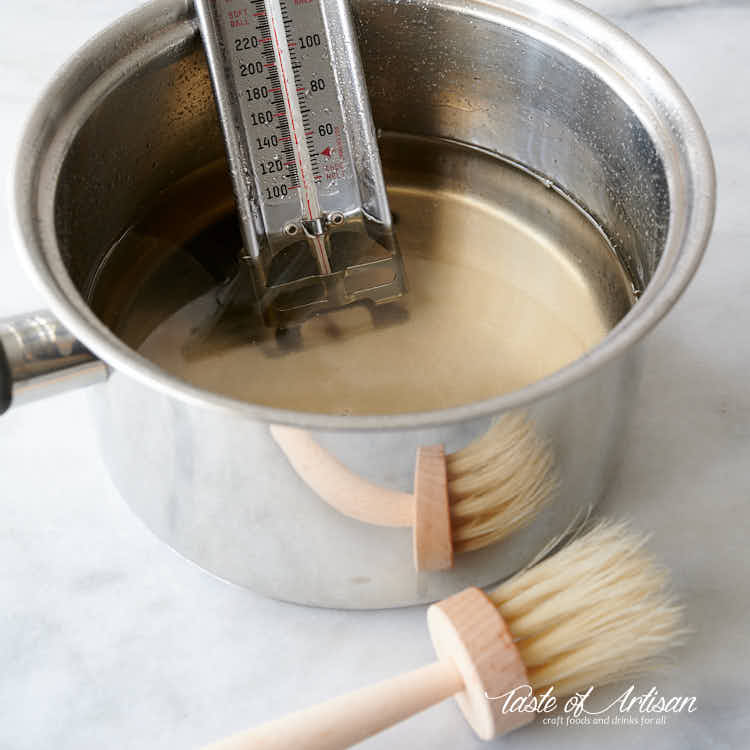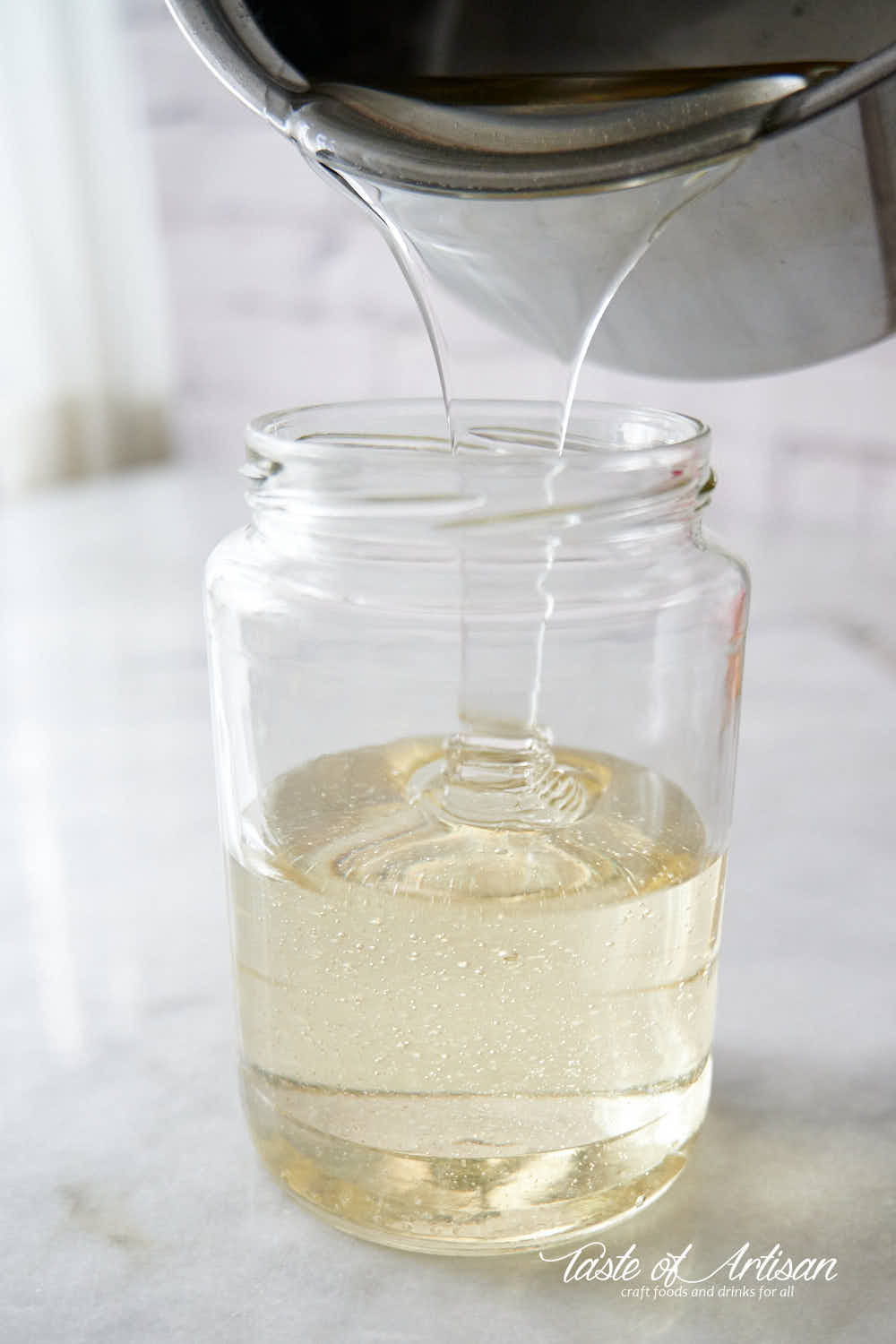Invert sugar is mostly reserved for the professional pastry chefs and bakers and is generally used in combination with sugar (sucrose). It has a lot of benefits and can be purchased at pastry supply stores or made at home with relative ease.
What is invert sugar?
Invert sugar (also referred to as inverted sugar or inverted sugar syrup) is a mixture of two simple sugars - glucose and fructose. Invert sugar is sweeter than white sugar, having a sweetening power of 125% compared to sucrose (ordinary white sugar). Bakers often refer to invert sugar as trimoline, which is the brand name used by one of its manufacturers.
What are the benefits of invert sugar?
Invert sugar is frequently used when making fudge, creams, ganaches, candies, fondant, cakes, and other products in conjunction with glucose syrup, to control crystallization and help create the small sugar crystals that result in a smooth texture. It's best suited for products with a high water content that must be kept soft.
Invert sugar inhibits crystallization in creams and provides aroma and color when heated.
It also contributes to potential Maillard browning, resulting in a more visually appealing and more flavorful product.
Fructose in invert sugar enhances favor, especially in fruity preparations such as sorbet or jam.
Invert sugar acts as a humectant, helping to retain moisture in the finished product and prevent it from drying out. This property is also referred to as increased hygroscopicity. For this reason, some bakers use it more than other sweeteners.
Invert sugar also has preservative effects due to its high degree of solubility, which lowers the water activity level, resulting in longer shelf life for the finished product.
Adverse effects of invert sugar
When used in excess, invert sugar gives fudge and other confections an excessively soft, pliable texture, which is undesirable. Another adverse effect may be an overly sweet confection.
Finally, baked goods prepared using invert syrup brown at a lower temperature and require shorter baking times than those made with sucrose.
For the reasons mentioned above, invert sugar is used only as an accompaniment to sucrose.
How is invert sugar made?
Invert sugar is made by splitting disaccharide sucrose into its two component monosaccharides, fructose (also known as levulose) and dextrose (also known as glucose).
The conventional way to make invert sugar is by the hydrolysis of sucrose to glucose (dextrose) and fructose. This is achieved by subjecting a sucrose solution to acid and heat. However, acid hydrolysis has a low conversion efficiency and high-energy consumption.
This conversion can also be achieved by the enzymatic action of invertase (immobilized yeast cells) on sucrose with a conversion efficiency of almost 100% without the inherent disadvantages of acid hydrolysis. You can read more about the production of invert sugar in the Invert Sugar Production Line. This is how commercial producers make invert sugar today.
Best way to make invert sugar at home
At home, the best way to make invert sugar is by heating white sugar, water, and citric acid or cream of tartar.
Chef Eddy provides the most commonly used recipe for invert sugar. I've successfully made invert sugar using this recipe many times and this is my 'go-to' recipe.
To make 1 kilo of invert sugar, his recipe calls for 1 kg (4 cups + 6 Tbsp) extra fine granulated sugar, 480 g (2 cups) water and 1 g (1/4 tsp) cream of tartar or citric acid.
You will need a good candy thermometer, a pastry brush, and a thick-bottomed stockpot.

The ingredients are stirred and brought to a boil in a non-reactive saucepan over medium-high heat. Once the mixture is boiling, reduce the temperature to medium and continue boiling without stirring. Stirring will cause crystallization, which is undesirable.
Any sugar crystals formed on the walls of the saucepan are washed with a pastry brush dipped in water, without the brush ever touching the mixture. You want the water to gently roll down into the mixture. This water will not cause any adverse effects.
The mixture is boiled to 236F (114C), after which it is removed from heat, covered and cooled down to room temperature, undisturbed. Homemade invert sugar will store in a fridge for at least six months.

Another recipe, slightly more complicated, was provided by Jean-Pierre Wybauw in his Fine Chocolates 2: Great Ganache Experience book. You can find this recipe re-published and discussed on eG Forums.
Where to buy invert sugar?
Invert sugar is made commercially and is available online as Inverted Sugar Syrup or Liquid Invert Sugar. You can find it under the brand name of Trimoline. You can buy it in bulk from The Pastry Chef or The Pastry Depot.
Invert sugar substitutes
In a pinch, you may substitute liquid honey, corn syrup, or maple syrup for invert sugar. All three contain some amount of invert sugar. Keep in mind though, these products will impart their flavor, and the results will be a bit different.
Sources:
The Art of the Chocolatier: From Classic Confections to Sensational Showpieces
Chocolates and Confections: Formula, Theory, and Technique for the Artisan Confectioner



Patricia Cameron says
Invert sugar recipe is great. Two things may help people with trouble with crystals. I use cane sugar and pure water and medium heat to bring it to boil but then turn temperature to med low until reaching 236. Not disturbing it after it is cooked, as your recipe states, is a very important step. I keep mine in refrigerator in a heat safe canning jar. I set jar in warm water to make it more liquid when I go to use it.
I am attaching a recipe that I invented/ tweaked because I have an allergy to corn. Recipes for pastry cream are getting very rare that do not contain cornstarch. My husband is allergic to milk. The milk-free version of this pastry cream looks like the real thing and I am very excited to have a professional try it and publish it if you find it worthy. Thank you.
Trish’s no cornstarch - all flour Pastry Cream, Milk and Milk Free Version
This recipe makes about 1 ½ cups. Double it if using it for thick tarts without whipping cream (see below). This is a modification of the one found in French Pastry book by Haley – Pastry shop recipes- Trish’s modified version never taste of raw flour. See ** for Milk Free version.
Gently melt 15 grams of Ghee* (or about 1 Tablespoon butter) in an even heating pan like Farberwear - remove from burner. Add 35 grams of Bob’s pastry flour or all purpose flour (Or about 4 ½ tablespoons) and mix until all the flour is moistened by the Ghee and a thick paste is formed. (Do not use King Arthur All Purpose flour - its high protein content 11.7 can result in a “grainy” texture)
Add 1/3 cup sugar and stir in until it looks like beach sand
Add 1 egg yolk and 1 whole egg
Stir with a whisk until smooth
Add 1/8 teaspoon salt and ¼ teaspoon real Vanilla or homestyle rum Vanilla
Measure 1 cup of milk in a microwave safe cup or bowl and microwave for 1-2 minutes until nearly hot to the touch.
Slowly pour the heated milk into the pan and beat with a whisk until all lumps are gone.
Place the pot on MED heat and stir constantly; use a spoon at first and when it starts to thicken switch to a whisk. Stir like crazy until the liquid becomes a thick paste and center of the pot is sending up a boil bubble. Turn off the burner but keep pot on the burner and stir for 2 more full minutes. If pan gets too cool turn burner back on for 20 seconds.
Remove from heat, transfer to a bowl do not cover until it reaches room temperature. Stir it every few minutes to prevent a “crust” from forming. If it does form, stir or beat it back into the pudding before adding other ingredients.
Can be used as is as pudding, tart filling or whip ¼ cup whipping cream and fold it into the pastry cream to lighten it for cream puff filling, cream pies, etc. Pastry cream is also used in souffles. Pastry Cream made with milk or milk free can be lightened with “Safe Meringue”.
Keep chilled and serve within 3 days.
*The Ghee- flour paste eliminates the Raw Flour taste in the final pudding. Ghee can be made from any butter, salted or not. Gently melt it and cook on low until it stops bubbling, spoon off milk solids or pour through a coffee filter to catch the solids. Store Ghee in jar in refrigerator or freeze. 0.5 oz is about 1 tablespoon.
** Milk free - Vanilla Pastry Cream - Use light olive oil instead of the Ghee, water instead of the milk and increase the Vanilla to ½ teaspoon. (Low milk version uses Ghee and water)
Victor @ Taste of Artisan says
Thank you for the tips, Patricia. You've provided a wealth of useful information. I am sure many people will find it extremely useful. Best wishes!
Kaye Blewett says
I have made the Chef Eddy recipe three times but sadly after a couple of weeks it crystalises and becomes solid and unusable. Not sure what I am doing wrong?
Victor @ Taste of Artisan says
Something must be off as mine doesn't begin to visibly crystallize for months, which I am quite happy about as I don't use it much or too often; I keep it in a cool, dark place. It's hard to say what caused crystallization in your case but here is a very informative discussion - https://cooking.stackexchange.com/questions/76048/why-does-my-invert-sugar-always-crystallize - about the same problem with possible solutions to try. Good luck!